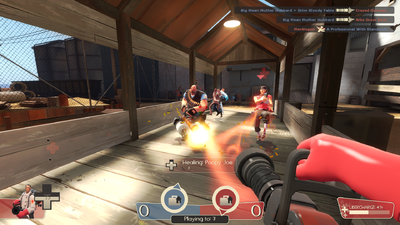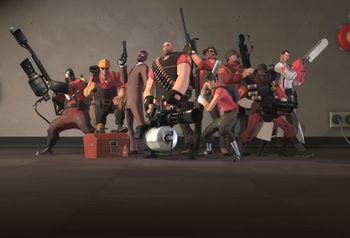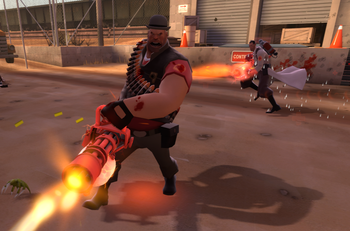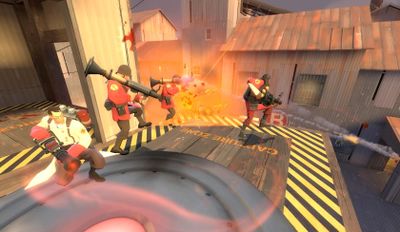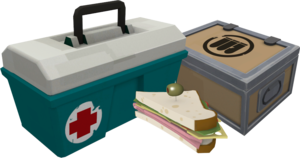Difference between revisions of "Mechanics/es"
(→Weapon types: Translated) |
(→Status effects: Translated) |
||
| Line 69: | Line 69: | ||
Algunas armas no son cuerpo a cuerpo, pero éstas no necesitan munición (como el [[Jarate/es|Fraskungfú]]). Este se podrá recargar de varias maneras, yendo al ressuply, reapareciéndo, o por tiempo (como el [[Chargin' Targe/es|Targe de Carga]]). Hay algunas que no necesitan munición ni recargar ni nada, como la [[Medi Gun/es|Pistola Médica]] (que necesita curar para la [[ÜberCharge/es|SuperCarga]]) y el [[Buff Banner/es|Estandárte de Ánimo]] (que necesita llenar su Furia para su uso). | Algunas armas no son cuerpo a cuerpo, pero éstas no necesitan munición (como el [[Jarate/es|Fraskungfú]]). Este se podrá recargar de varias maneras, yendo al ressuply, reapareciéndo, o por tiempo (como el [[Chargin' Targe/es|Targe de Carga]]). Hay algunas que no necesitan munición ni recargar ni nada, como la [[Medi Gun/es|Pistola Médica]] (que necesita curar para la [[ÜberCharge/es|SuperCarga]]) y el [[Buff Banner/es|Estandárte de Ánimo]] (que necesita llenar su Furia para su uso). | ||
| − | === | + | ===Efectos que alteran el estado=== |
| − | [[Image:ÜberCharge Kritzkrieg.png|thumb|right|350px| | + | [[Image:ÜberCharge Kritzkrieg.png|thumb|right|350px|Un [[Heavy/es|Heavy]] bajo los efectos de una [[Crit boost/es|Carga Crítica]] de un [[Medic/es|Médic]] con su [[Kritzkrieg/es|Kritzkrieg]].]] |
| − | {{hatnote| | + | {{hatnote|Veasé también: [[Weapons/es|Armas]]}} |
| − | + | Los efectos que alteran el estado incluye una gran variedad de armas que inducen en las condiciones del jugador, como el [[Fire/es|fuego]] o la [[Bleeding/es|sangre]]. Todas ellas se pasan al morir, o cambiar de clase, pero sobretodo son elminadas al recibir una [[ÜberCharge/es|Supercarga]]. O también desaparecen por una inmersión en el [[water/es|agua]] o recibiendo [[healing/es|curación]]. | |
| − | * '''[[ÜberCharge]]:''' | + | * '''[[ÜberCharge/es|SuperCarga]]:''' Un jugador con SuperCarga será totalmente invulnerable a todo (excepto el daño ambiental). Los jugadores con SuperCarga se pueden identificar por que son totalmente coloreados de el color de su equipo y cromados. |
| − | * '''[[Crit boost]]:''' | + | * '''[[Crit boost/es|Carga Crítica]]:''' Todos los ataques provenientes de éste jugador serán [[Critical hit/es|Crítico]]s. Además éste tendrá una electricidad del color de su equipo. Puede ser causada por la [[Kritzkrieg/es|Kritzkrieg]], los [[Killing Gloves of Boxing/es|K.G.B]], la [[Frontier Justice/es|Justiciera]], y el [[Chargin' Targe/es|Targe de Carga]]; lo mismo ocurre cuando capturas la [[CTF/es|Inteligencia enemiga]] en la [[First Blood/es|Primera Sangre]] de una arena, y durante la [[humiliation/es|Humillación]]. |
| − | * '''[[Mini-Crit]] | + | * '''Carga [[Mini-Crit/es|Mini-Crítica]]:''' Todos los ataques provenientes de éste jugador serán [[Mini-Crit/es|Mini-Crítico]]s. Las armas con ésta carga tendrán una tonalidad de color similar a la de su equipo, será un azul verdoso para el equipo [[BLU/es|BLU]] y uno anaranjado para el equipo [[RED/es|RED]]. Causados por la [[Crit-a-Cola/es|Criticola]], el [[Buff Banner/es|Estandárte de Ánimo]], y el [[Jarate/es|Fraskungfú]]. |
| − | * '''[[Overheal]]:''' | + | * '''[[Overheal/es|Overheal]]:''' Un jugador overhealeado tendrá más del 100% de su vida (150%). Éstos desprenderán un icono de una cruz, del color de su equipo. Éste efecto es causado por la [[Medi Gun/es|Pistola Médica]], la [[Kritzkrieg/es|Kritzkrieg]], la [[Eyelander/es|Intuertal]], el [[Powerjack/es|Batemartillo]], y el [[Horseless Headless Horsemann's Headtaker/es|Decapitador del Jinete Decapitado sin Montura]]. |
| − | * '''[[Fire]]:''' | + | * '''[[Fire/es|Fuego]]:''' Un jugador ardiendo pierde vida cada cierto tiempo (esto es conocido como "quemado"), y los [[Pyro/es|Pyro]] son inmunes a esto. Para más detalles, esto quita 3 de vida cada medio segundo, durante 10 segundos, con un total de 60 de daño (el [[Degreaser/es|Desengrasador]] solo quita 2, con un total de 40). Causado por el [[Flamethrower/es|Lanzallamas]], [[Backburner/es|Dragón]], [[Degreaser/es|Desengrasador]], una [[Huntsman/es|Flecha]] ardiendo, y una [[Flare Gun/es|bengala]]. |
| − | * '''[[Bleeding]]:''' | + | * '''[[Bleeding/es|Sangrado]]:''' Un jugador sangrando pierde vida cada cierto tiempo. Su duración es de 5 ó 6 segundos, quitando 3-5 de vida cada medio segundo. Causado por la [[Southern Hospitality/es|Hospitalidad Sureña]], [[Tribalman's Shiv/es|la Cuchilla Tribal]] y el [[Boston Basher/es|Boston Basher]]. |
| − | * '''[[Slowdown]]:''' | + | * '''[[Slowdown/es|Slowdown]]:''' Algunas armas producen una [[speed/es|lentitudo de movimiento]] por impacto. Ésto es causado por la [[Natascha/es|Natscha]] y la [[Shortstop/es|Paratenseco]]. |
| − | * '''[[Jarate]] | + | * '''[[Jarate/es|Meado]]:''' Los ataques sobre los enemigos cubiertos de Fraskung-Fú serán [[Mini-Crit/es|Mini-Crítico]]s. Los jugadores meados tendrán una tonalidad amarilla y gotearán. Causado por el [[Jarate/es|Fraskungfú]] y el [[Sydney Sleeper/es|Adormecedor de Sydney]]. |
| − | * '''[[Mad Milk| | + | * '''[[Mad Milk/es|Lechado]]:''' Los jugadores que ataquen a los enemigos lechados se curarán un 75% de la vida que le haya quitado. Los jugadores lechados gotean partículas blancas. Causado por la [[Mad Milk/es|Leche Loca]]. |
| − | * '''[[Bonk! Atomic Punch| | + | * '''[[Bonk! Atomic Punch/es|Evasión]]:''' La evasión previene al jugador de daño enemigo, no recibirás daño pero si sufriras los efectos de [[knock back/es|retroceso]]. Las acciones de evasión producen un efecto de distorsión y cuando este recibe un impacto emitirá un mensaje sobre él que dira "Miss" (Fallo). Causado por [[Bonk! Atomic Punch/es|¡Plonk! La Bebida Salvavidas]]. |
| − | * '''[[Battalion's Backup| | + | * '''[[Battalion's Backup/es|Media-Carga]]:''' Hace la mitad de efecto que una SuperCarga, previniendo a los aliados, en parte, de impactos y deshabilitando los efectos de [[knock back/es|retroces]] por [[Critical hit/es|críticos]] y [[Mini-Crit/es|mini-crítico]]s, además da un 35% de reducción de daño a todo. Los jugadores que reciben esto tienen un anillo bajo ellos (al igual que con el [[Buff Banner/es|Estandárte de Ánimo]]). Causado por el [[Battalion's Backup/es|Refuerzo del Batallón]]. |
| − | * ''' | + | * '''Aturdimiento:''' Los jugadores aturdidos van un 10% más lentos, no pueden agacharse, disparar, ni cambiar de arma (Pero sí [[taunt/es|burlarse]]). Cada personaje tiene una animación distinta emitida al ser aturdido. Causado por el [[Sandman/es|Somnífero]], [[humiliation/es|fase de humillación]], y [[Ghost/es|fantasmas]]. |
| − | + | Además de éstas alteraciones, hay otras que varían según las armas [[loadout/es|equipadas]]. | |
==Environment== | ==Environment== | ||
Revision as of 09:25, 16 January 2011
| « | ¡Así es como se hace, tío!
Haz clic para escuchar
— El Soldier
|
» |
La Mecánica de Team Fortress 2 define las normas y posibilidades de los jugadores, servidores, y el contenido editable. El comprender estos conceptos hace de Team Fortress 2 un mejor juego para todos.
Índice
Motor del juego
El Team Fortress 2 tiene el motor Source (Source Engine), el cual se ha diseñado para PC, X-Box 360, PS3, y ordenadores Mac. El TF2 aguanta hasta 24 jugadores (18 en X-Box 360 y PS3), aunque hay algunos servidores modificados de forma que puedan tener hasta 32 jugadores (Solo en PC/Mac), ya que en PC hay ventajas de configuración con los comandos de la Consola.
Clases
Existen nueve clases jugables en Team Fortress 2. Clasificadas en "Ataque", "Defensa", y "Apoyo", aunque que esta clasificación no influye en el juego. Sus características pueden ser modificadas según su equipamiento.
 Scout: Clase ofensiva con un 133.33% de velocidad y 125 puntos de vida, especializada en capturar puntos o inteligencias e infiltrarse para matar. Puede realizar doble salto y capturar los puntos de control el doble de rápido que el resto de clases.
Scout: Clase ofensiva con un 133.33% de velocidad y 125 puntos de vida, especializada en capturar puntos o inteligencias e infiltrarse para matar. Puede realizar doble salto y capturar los puntos de control el doble de rápido que el resto de clases. Soldier: Clase ofensiva con un 80% de velocidad y 200 puntos de vida. Además, puede realizar saltos cohete.
Soldier: Clase ofensiva con un 80% de velocidad y 200 puntos de vida. Además, puede realizar saltos cohete. Pyro: Clase ofensiva con un 100% de velocidad y 175 puntos de vida. Puede quemar y reflejar proyectiles, además de poder hacer saltos cohete con ellos.
Pyro: Clase ofensiva con un 100% de velocidad y 175 puntos de vida. Puede quemar y reflejar proyectiles, además de poder hacer saltos cohete con ellos. Demoman: Clase defensiva con un 93.33% de velocidad y 175 puntos de vida, especializada en cubrir áreas con sus bombas lapa o demoler construcciones. Puede realizar saltos con bombas lapa.
Demoman: Clase defensiva con un 93.33% de velocidad y 175 puntos de vida, especializada en cubrir áreas con sus bombas lapa o demoler construcciones. Puede realizar saltos con bombas lapa. Heavy: Clase defensiva con un 76.67% de velocidad y 300 puntos de vida. Puede recibir una gran cantidad de daños sin morir, gracias a su elevada cantidad de puntos de salud.
Heavy: Clase defensiva con un 76.67% de velocidad y 300 puntos de vida. Puede recibir una gran cantidad de daños sin morir, gracias a su elevada cantidad de puntos de salud. Engineer: Clase Defensiva con un 100% de velocidad y 125 puntos de vida, especializada en proteger áreas con sus construcciones.
Engineer: Clase Defensiva con un 100% de velocidad y 125 puntos de vida, especializada en proteger áreas con sus construcciones. Medic: Clase de apoyo con un 106.67% de velocidad y 150 puntos de vida, puede curar a otras clases de su propio equipo. Sus puntos de salud se regeneran con el paso del tiempo, y puede realizar supercargas.
Medic: Clase de apoyo con un 106.67% de velocidad y 150 puntos de vida, puede curar a otras clases de su propio equipo. Sus puntos de salud se regeneran con el paso del tiempo, y puede realizar supercargas. Sniper: Clase de apoyo con un 100% de velocidad y 125 puntos de vida, ideal para matar enemigos a larga distancia. Puede matar instantáneamente al disparar en la cabeza.
Sniper: Clase de apoyo con un 100% de velocidad y 125 puntos de vida, ideal para matar enemigos a larga distancia. Puede matar instantáneamente al disparar en la cabeza. Spy: Clase de apoyo con un 100% de velocidad y 125 puntos de vida, ideal para cometer asesinatos sigilosamente. Puede disfrazarse, hacerse invisible, y matar de un golpe por la espalda.
Spy: Clase de apoyo con un 100% de velocidad y 125 puntos de vida, ideal para cometer asesinatos sigilosamente. Puede disfrazarse, hacerse invisible, y matar de un golpe por la espalda.
Entre los datos de el juego existe una décima clase, llamado El Civil, pero éste nunca se ha incluido al juego, es tan solo un archivo perdido de varios juegos en los que se usa, como en Half-Life o Counter-Strike.
Combate
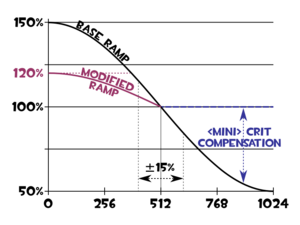
El combate es el primer objetivo entre ambos equipos. Pero existen varios factores en ésto:
Daño
La mayoría de armas producen daños reflejados en los puntos de vida. A no ser que el servidor esté modificado, las armas no producen fuego amigo, aunque sí pueden dañar al usuario. El daño producido por un arma está sujeto a diferentes variables, causando mayores daños a blancos cercanos que a enemigos más lejanos; al basarse en la distancia entre el atacante y el blanco en cada disparo (aún así, la distancia no influye en los críticos, pero solamente la cercanía influye en los minicríticos). Aunque la mayoría de armas no producen daño dependiendo de la ubicación a la cual se dispara, existen excepciones como la puñalada del Spy y los disparos a la cabeza del Sniper.
El daño explosivo es reducido según se incrementa la distancia del objetivo con respecto al centro de la explosión. Mientras que las armas explosivas pueden dañar a sus usuarios, suelen otorgar una reducción de daños con respecto a los ataques propios.

A no ser que se encuentren desactivados por el servidor, muchas armas poseen un modificador aleatorio en el daño (aproximadamente 10%, en la mayoría), pudiendo convertirse estos daños en golpes críticos de una manera semialeatoria (muchas armas tienen un porcentaje entre 2 y 12% de producirlos, basado en los daños recientes; pasando a ser entre 15 y 25% en las armas de cuerpo a cuerpo y existiendo por otro lado varias armas que no producen daños críticos aleatorios). Los daños críticos no sufren el influjo de la variación aleatoria de daños ni de las modificaciones de daños según la distancia. Normalmente, los críticos son acompañados de efectos que poseen el color del equipo del jugador y sonidos eléctricos (siendo mejor apreciables en proyectiles explosivos). Al golpear con un crítico, aparecerá un texto sobre la cabeza del blanco indicándolo, se reproducirá un sonido de golpe diferente y el retroceso se verá incrementado. El multiplicador de daño crítico ronda entre 200 y 300%, según el arma. Los ataques críticos no provocan daños críticos a sus usuarios, aunque produzcan pistas visuales o auditivas que indiquen que sí los producen.
Otros estados y armas del juego tienen la capacidad de producir minicríticos, los cuales funcionan de una manera similar a los críticos, aunque solamente proporcionan un incremento en daños causados de un 35%, provocan menor retroceso que los críticos y tampoco producen los mismos efectos visuales. A pesar de no encontrarse sujetos al descenso de daños por la distancia, infligen mayores daños al producirse a quemarropa. Si un ataque produce crítico y minicrítico, los daños no serán acumulados, solo se provocará el daño crítico. Igual que los ataques críticos, los minicríticos no otorgan daños elevados a sus usuarios.
Ni los daños críticos ni los minicríticos influyen a las construcciones, al contrario que los ataques modificados por la distancia. Los daños causados por las construcciones tampoco pueden ser críticos ni son modificados por la distancia, aunque sí pueden convertirse en minicríticos.
Detección de daños
La mayoría de las armas lanzan proyectiles o son de Registro de Impacto. Las armas de proyectiles, como el Lanza Cohetes, producen el movimiento de objetos y efectos determinados según el estado del Servidor, los cuales funcionarán de una manera u otra según la latencia del jugador. Los proyectiles usualmente tienen una únca norma de físicas aplicadas a la separación de el jugador y él, y la velocidad del jugador no es usada para determinar la velocidad inicial del proyectil. Los proyectiles no aparecen desde el centro de la pantalla, si no desde un lado de ella, en el que aparece el arma. La detección de la colisión del proyectil no usa la conformación de le modelo llamada hitbox, si no que en su lugar usa un, singular sistema, basado en la posición de la hitbox propia del proyectil sobre el modelo del jugador. El ataque de las llamas del Pyro basado en partículas sigue la mecánica de las armas de proyectiles.
Las armas de Registro de Impacto producen un impacto (o fallo) instantáneo. Las armas cuerpo a cuerpo y las balas tienen generalmente éste método. Éstas armas determinan la colisión basada en el estado del atacante (al contrario que los proyectiles, que usan el estado del servidor), que puede producir alguna detección incorrecta ("Yo siempre estoy tras una covertura; ¿cómo vas a dispararme?"). Las armas de Registro de Impacto se producen desde el centro de la pantalla. El Registro de Impacto de las armas Cuerpo a cuerpo se basa en la hitbox de el modelo.
La mayoría de las armas no Cuerpo a cuerpo usan ataques de balas y fogonazos (Como la Metralleta y la Escopeta). Por defecto, la dirección de éstas es aleatoria, pero con el cvar tf_use_fixedweaponspreads estandarizas el fogonazo a un cuadrado perfecto. Las armas no tienen retroceso, a excepción del atributo de la Embajadora.
Retroceso
Muchas armas producen el retroceso (unos en mayor y otros en menor medida). Que un ataque tenga o no retroceso incluirá los requesitos del daño, crítico o mini-crítico, y los efectos propios del arma. El Retroceso se puede usar para manipular la posición y el movimiento de los jugadores, especialmente a los jugadores que estén saltando y haciendo Rocket Jumps o Sticky jump. Algunas armas y habilidades, como la Dispensadora de Caña y el Aire Comprimido, se basan en un único retroces. Los objetivos con SuperCarga no son influenciados por los retrocesos enemigos, al igual que los Spys disfrazados.
Tipos de Arma
Cada clase tiene un set único de armas, las cuales ocupan los espacios 1, 2 y 3 (normalmente es armas Primaria, Secundaria, y Cuerpo a cuerpo, respectivamente). Algunas clases constan de espacios adicionales, como el Engineer con sus PDAs y el Spy con su Kit de Disfrazes. Todas las armas de cada clase pueden ser elegidas en el menú de equipamiento.
La mayoría de las armas que no son Cuerpo a Cuerpo requieren Munición para su uso. Algunas constan de varios cargadores para su uso (Como la Pistola) y otras tienen una sola tanda de balas (como la Ametralladora). Las armas de recarga pueden ser de dos tipos, de una única recarga (Como el Revólver) o secuenciales (como la Escopeta). La recarga puede interrumpirse cambiando de arma. Cuando se está recargando un arma secuencial, se puede ver una animacion distinta en la primera animación de recarga (por ejemplo el Lanzagrandas tarda 1.24 segundos para recargar el primer proyectil, y 0.6s para los demás).
Algunas armas no son cuerpo a cuerpo, pero éstas no necesitan munición (como el Fraskungfú). Este se podrá recargar de varias maneras, yendo al ressuply, reapareciéndo, o por tiempo (como el Targe de Carga). Hay algunas que no necesitan munición ni recargar ni nada, como la Pistola Médica (que necesita curar para la SuperCarga) y el Estandárte de Ánimo (que necesita llenar su Furia para su uso).
Efectos que alteran el estado
Los efectos que alteran el estado incluye una gran variedad de armas que inducen en las condiciones del jugador, como el fuego o la sangre. Todas ellas se pasan al morir, o cambiar de clase, pero sobretodo son elminadas al recibir una Supercarga. O también desaparecen por una inmersión en el agua o recibiendo curación.
- SuperCarga: Un jugador con SuperCarga será totalmente invulnerable a todo (excepto el daño ambiental). Los jugadores con SuperCarga se pueden identificar por que son totalmente coloreados de el color de su equipo y cromados.
- Carga Crítica: Todos los ataques provenientes de éste jugador serán Críticos. Además éste tendrá una electricidad del color de su equipo. Puede ser causada por la Kritzkrieg, los K.G.B, la Justiciera, y el Targe de Carga; lo mismo ocurre cuando capturas la Inteligencia enemiga en la Primera Sangre de una arena, y durante la Humillación.
- Carga Mini-Crítica: Todos los ataques provenientes de éste jugador serán Mini-Críticos. Las armas con ésta carga tendrán una tonalidad de color similar a la de su equipo, será un azul verdoso para el equipo BLU y uno anaranjado para el equipo RED. Causados por la Criticola, el Estandárte de Ánimo, y el Fraskungfú.
- Overheal: Un jugador overhealeado tendrá más del 100% de su vida (150%). Éstos desprenderán un icono de una cruz, del color de su equipo. Éste efecto es causado por la Pistola Médica, la Kritzkrieg, la Intuertal, el Batemartillo, y el Decapitador del Jinete Decapitado sin Montura.
- Fuego: Un jugador ardiendo pierde vida cada cierto tiempo (esto es conocido como "quemado"), y los Pyro son inmunes a esto. Para más detalles, esto quita 3 de vida cada medio segundo, durante 10 segundos, con un total de 60 de daño (el Desengrasador solo quita 2, con un total de 40). Causado por el Lanzallamas, Dragón, Desengrasador, una Flecha ardiendo, y una bengala.
- Sangrado: Un jugador sangrando pierde vida cada cierto tiempo. Su duración es de 5 ó 6 segundos, quitando 3-5 de vida cada medio segundo. Causado por la Hospitalidad Sureña, la Cuchilla Tribal y el Boston Basher.
- Slowdown: Algunas armas producen una lentitudo de movimiento por impacto. Ésto es causado por la Natscha y la Paratenseco.
- Meado: Los ataques sobre los enemigos cubiertos de Fraskung-Fú serán Mini-Críticos. Los jugadores meados tendrán una tonalidad amarilla y gotearán. Causado por el Fraskungfú y el Adormecedor de Sydney.
- Lechado: Los jugadores que ataquen a los enemigos lechados se curarán un 75% de la vida que le haya quitado. Los jugadores lechados gotean partículas blancas. Causado por la Leche Loca.
- Evasión: La evasión previene al jugador de daño enemigo, no recibirás daño pero si sufriras los efectos de retroceso. Las acciones de evasión producen un efecto de distorsión y cuando este recibe un impacto emitirá un mensaje sobre él que dira "Miss" (Fallo). Causado por ¡Plonk! La Bebida Salvavidas.
- Media-Carga: Hace la mitad de efecto que una SuperCarga, previniendo a los aliados, en parte, de impactos y deshabilitando los efectos de retroces por críticos y mini-críticos, además da un 35% de reducción de daño a todo. Los jugadores que reciben esto tienen un anillo bajo ellos (al igual que con el Estandárte de Ánimo). Causado por el Refuerzo del Batallón.
- Aturdimiento: Los jugadores aturdidos van un 10% más lentos, no pueden agacharse, disparar, ni cambiar de arma (Pero sí burlarse). Cada personaje tiene una animación distinta emitida al ser aturdido. Causado por el Somnífero, fase de humillación, y fantasmas.
Además de éstas alteraciones, hay otras que varían según las armas equipadas.
Environment
Depending on map and server, the goals and rules of TF2 gameplay can change dramatically. By understanding these variables in gameplay (and how to parse them in the Server Browser), players can find a game environment that suits them and fully contribute to their team's goals.
Objectives
Maps are made based on a variety of game modes, which are used to determine the objectives for both teams. Teams may compete over the same goals (such as in Push Control Point and King of the Hill maps) or oppose each other in an offense vs. defense setup (such as in Attack/Defend Control Point and standard Payload maps).
Many game modes use control points, which are captured when a player whose color does not match that of the control point stands on it for a set time. The capture time varies by map, and its speed is increased when more players stand on it (though each player beyond the first provides diminishing returns). Capture is halted when an opposing team member stands on it in defense, and capture progress is gradually undone when no capturing team mates stand on the point. Control points cannot be captured while "locked." Payload carts are pushed and halted the same way control points are captured, though instead of capturing a Payload cart, the pushing team tries to bring it to a checkpoint.
In all official maps with offense vs. defense game modes, BLU plays offense while RED plays defense. In such maps, BLU tends to have faster respawn times, but RED is given a setup time to prepare a robust defense.
- Arena: Players spawn only at round start, with no respawning. After a set time, a neutral control point unlocks, which can be captured to win the round. If all members of a team die, that team loses the round. Has first blood and automated team assignment/shuffling by default. Official arena maps don't have resupply cabinets.
- Capture the Flag (CTF): Teams work to capture the opposing side's Intelligence faster than their opponents do the same. Any player can pick up an enemy's Intelligence, and their team gains a point if that player returns the enemy's Intelligence to their team's own original Intelligence spot. The Intelligence drops on command or when its carrier dies; it's returned to its original location if it remains on the ground for a set time after being dropped.
- Control Point, Push (CP): Each team starts with two locked control points and fight for the middle, neutral control point. From then on, at any given time, each team's furthest control point is unlocked, while all others are locked. Teams must capture all five control points to win the round.
- Control Point, Attack/Defend (CP): If the offensive team captures all of the defense's control points before time runs out, they win (if defense can prevent this, they win). In most maps, only one or two control points are unlocked at a time (the notable exception being Steel).
- King of the Hill (KOTH): Each team has their own countdown timer, and a team wins when their countdown timer reaches zero. A team's timer counts down while they own the control point, but is frozen while that team does not have ownership of the control point.
- Payload (PL): Offense pushes the Payload cart in a manner similar to capturing a control point, trying to reach checkpoints instead of finishing point captures. The Payload cart supports allies as if it were a Nivel 1 Dispenser. Offense wins if the cart reaches the final checkpoint (if defense can prevent this, they win).
- Payload Race (PLR): Essentially identical to Payload, but instead of offense vs. defense, each team pushes their own cart in an attempt to reach the finish before the opposing team does.
- Territory Control (TC): Each team is randomly assigned territories, and rounds consist of each team trying to contest one of their opponent's control points (while the opposing team tries to capture one of theirs). Most of the map is locked during gameplay, consisting of only one territory vs. one territory. After enough successive wins, a round takes place at the losing side's base point, which they must defend against the offense-only opposing team.
- Training Mode (TR): Training maps are for practicing skills against obstacles and/or bots and learning through tutorials. They are often played with only one human player, or at the very least, no opposing human sides.
Map elements
Players start the round in their team's respawn room, where they can change class and loadout. Most respawn rooms contain resupply cabinets, which fully restore health, restock weapon ammo, refill most item meters, and remove most negative status effects, though a similar effect can be achieved by class switching. Upon dying, a player waits to respawn in a respawn wave, which typically come at ten- or five-second intervals (the exact wait time for respawning varies by map, team color and size, objective status, and server settings), at which point they appear at their team's furthest respawn room; respawn rooms can be earned by capturing points or pushing Payload carts to checkpoints, and can be lost if the opposing team makes such progress themselves.
Many maps make use of doors. Although their visuals suggest otherwise, doors are handled by the server as being either completely open or completely shut, alternating between the two instantly. Most doors are opened when a player of the appropriate team(s) approaches them from the appropriate side(s) (most doors away from respawn areas open for anyone coming from any direction), closing when no such players are nearby anymore. Some doors remain locked until certain conditions are met, such as control points being captured or Payload cart checkpoints being reached. Some effects, such as Jarate and Mad Milk splashes, can go through doors.
The boundaries and surfaces of maps are not determined by visual elements, but invisible surfaces that determine where players and projectiles can go. All maps--even outdoor ones--have player ceilings and walls, though they may be invisible, and projectiles may even appear to go through them. Additionally, many surfaces and objects in the game that appear to take physical space are completely ignored for collision detection, with players and projectiles passing through them as if nonexistant; these surfaces can be used for hiding stickybombs or spamming targets from cover.
Maps usually have pickups placed in various locations. Map-specific health and ammo pickups will remain in place until grabbed, respawning after a ten-second delay. The map health pickups restore 20.5%, 50%, or 100% health based on size (pill bottle, first aid tin, and ice cooler, respectively); similarly, the map ammo pickups restore 20.5%, 50%, or 100% ammo and 41, 100, or 200 metal based on size (small grey metal box, medium beige metal box, and large wood crate, respectively). When players die, they usually drop weapons that can be picked up for 50% ammo and 100 metal (unless the dropped item was an Engineer toolbox, which drops 100% ammo and 200 metal); destroyed buildings also leave behind metal debris, which can be picked up for ammo and metal. A Heavy who dies with a Sandvich or Dalokohs Bar active will instead drop that, which can be picked up for 50 health points (75 for Scouts).
Server settings

Server settings can have a strong impact on gameplay in terms of performance and game balance. Players can select what kind of server on which they want to play using the Server Browser, filtering based on tags (which include game modes and changes to respawn times), player count, map, latency, and the like. Generally, servers closer to the player's location will have reduced latency, resulting in faster connection and more accurate hit detection. Game smoothness is also affected by the server's hardware and networking settings, especially at higher player counts or when running some mods.
Servers can run scripts and configs just as a player can, with commands from clients issued by rcon. For more unique functionality, there are numerous server plugins to modify gameplay or provide administrative or stat assistance, the most common being SourceMod and HLStatsX. Instead of running plugins, servers can use logs to interact with third-party match-making programs, such as TF2 Lobbies, which let them see stats out-of-game.
There are a variety of server settings that can change gameplay without running plugins or external programs. These include...
- Respawn times: Respawn times can be changed to either be shorter or effectively removed entirely. These can cause fluctuations in map and class balance, though combat is more steadily provided.
- Damage settings: Servers can disable random criticals, random damage spread, and random pellet spread with ConVars. This is most commonly done on competitive servers and those that frequently play arena maps.
- Max players: While TF2 was originally designed for 24 players or fewer, servers can raise the limit to 32 at the cost of performance. This can cause in increase of spam that slows objective progress, but ensures a greater amount of combat in the map.
- Objective specifics: Map objectives can be specified from the server. For example, the CTF game mode can be played to a certain capture count, to a certain time limit, or both. Related options include disabling Crit boosts from First blood or Intelligence capture, changing the map time limit, and using a win difference mercy rule.
- Pure: The sv_pure ConVar dictates what kinds of custom files are allowed on the server. When set to 0, clients can use any custom content they wish. When set to 1, clients are allowed to use any files on the server's whitelist. When set to 2, clients may not use any custom content besides those specifically allowed by Valve.
- SourceTV: Servers can enable SourceTV to allow a large number of spectators to watch the game without risking interference. SourceTV acts like an observer player, taking up a server slot while not playing on either team. Unlike players, SourceTV broadcasts its spectator view from the server's IP address (using a different port).
- Special modes: There are server modes that can be applied to any map regardless of game mode, including highlander and tournament modes. These are more commonly reserved for private events and competitions.
Other common rule areas that vary by server include team size/balance rules, alltalk (cross-team) voice chat, and ping limits.
Configuration
There are a variety of ways to configure the Team Fortress 2 client. The choices players make in setting up TF2 can have impacts on game interaction, performance, and presentation. Most of these methods of customization are not available on console versions of the game, save main menu options.
Program setup
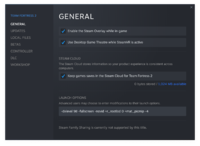
Some aspects of a player's machine, operating system, and Steam settings can affect TF2, and after a long history of updates, Team Fortress 2 has required an increasing amount of system resources to play at optimum frame rates. Additionally, some program features enabled by default may be undesirable for certain players, either due to performance issues or personal preference.
Steam, by default, enables both Steam Cloud syncronization and the Steam Community In-Game Overlay, which can be changed under Steam Settings. Within Steam's interface, players can also change launch options. As the name suggests, launch options are TF2 settings that are applied when the game is launched. Launch options can be accessed by opening the Properties of Team Fortress 2 in the Steam Library and clicking "Set Launch Options...". Launch options are separated by spaces and start with either a dash (if the command is not accessible through console commands) or a plus sign (if the command is a console command). Launch options can be used to achieve a variety of effects, including...
- Smooth Alt+Tabbing: Players who wish to view other windows and programs while running TF2 can run it in windowed mode with no border. This can be reversed with the full-screen launch option (-full). Example (for 1440x900 resolution): -window -noborder -w 1440 -h 900
- DirectX Level: Due to performance or personal preference, running TF2 in a low DirectX Nivel may be ideal. Example (for DirectX 8.1): -dxlevel 81
- Disabling Extraneous Features: Memory usage and performance drops can be minimized by disabling unused features. Example: -novid -nojoy -noipx -nocrashdialog
In addition to the Steam options, launch options can be specified for individual shortcuts to Team Fortress 2 by adding them to the file "C:\Program Files\Steam\Steam.exe" -applaunch 440 as a shortcut target. For example, this shortcut target would run TF2 full-screen with no intro video:
"C:\Program Files\Steam\Steam.exe" -applaunch 440 -full -novid
Video card and sound card configuration tools can be used to override game settings. For example, some video card utilities can change mat_picmip to values outside the normally-allowed bounds in Team Fortress 2, though this can be considered cheating.
Team Fortress 2 can be subject to operating system influences on mouse control. While this can be mitigated through launch options and registry edits, the easiest method to override this is by enabling Raw input (m_rawinput 1).
Customization
The most straightforward way for a player to customize their TF2 experience is the in-game options panels. In essence, the options panels are user-friendly ways to set ConVars, which can otherwise by set manually using the developer console. These panels are...
- Keyboard: Allows for simple key binding (can be done in command console with bind "KEY" "COMMAND"). The advanced options allow for fast weapon switching (change slots without confirming with the attack key) and enabling developer console (an important option for anyone using console commands).
- Mouse: Contains options for mouse and gamepad control. The "Raw input" option gives users more reliable mouse aiming by bypassing operating system mouse settings.
- Audio: Has a variety of sound-related options. Closed captions do not work without custom files.
- Video: Allows for some control of display settings, though some settings found in launch options and fps configs are missing or disabled. The advanced video options panel has the field of view (fov) slider, which can be increased to grant the player wider vision in-game.
- Voice: Has simple controls for in-game voice chat.
- Multiplayer options: Contains a great variety of gameplay-related options (mostly in advanced options) and content download control.
These settings are stored as ConVars in config.cfg, found in the cfg folder (which is usually found in C:\Program Files\Steam\steamapps\STEAMLOGIN\team fortress 2\tf\). By default, config.cfg is saved to the Steam Cloud.
In addition to the menu panels, ConVars can be changed with more specificity using scripting. Scripting allows for more advanced and uniquely tailored controls, dynamic player settings, and more optimized performance (performance scripts are usually just called "configs"). Script files are located in the cfg folder (usually found in C:\Program Files\Steam\steamapps\STEAMLOGIN\team fortress 2\). The file autoexec.cfg runs on game startup, and the class-named files (such as scout.cfg) each run when first spawning as the appropriate class. Most scripts are made using bind, alias, game commands, and/or ConVars; the wait command may be used to produce automated, chronologically sequenced functions, though a number of servers disable this with sv_allow_wait_command 0.
Many aspects of the TF2 interface can be customized by editing the Heads-up display, or "HUD". Most custom HUDs always work regardless of server settings, unless the HUD uses customized material files, which constitute custom content and are disabled by sv_pure servers (most HUDs only contain /resource/ and /scripts/ files, which are allowed in all pure settings).
Tools
There are a variety of first-party (some in-game and some not) and third-party tools to assist in playing, editing, and analyzing Team Fortress 2. These include...
- Demo Recording and Playback: Players can record demos of gameplay (record FILENAME in console) to watch or share later without using the resources necessary for live video capturing. Demos can be played with the console command playdemo FILENAME and captured to video using the startmovie command. PREC is a common, Valve-approved add-on to TF2 that automates demo recording.
- TF2 Tool Mode: TF2 can be run under a "tool mode" with the launch option -tools. The tool mode allows access to the Commentary editor, Material editor, and perhaps most notably, the Particle editor.
- Source SDK: The Source engine Software Development Kit, or SDK, is a set of programs that come with all Source engine games and run through Steam, including the Model Viewer (commonly used for posing wiki images) and Hammer editor (used for making maps). The SDK can be accessed in the Tools subsection of the Steam Library, and has its own wiki.
- GCFScape: One can examine and extract the contents of TF2 using GCFScape, a third-party application used by most custom content editors. GCFScape can also be used to validate or defragment game files. In order to view and edit VTF files extracted using GCFScape, VTFEdit is commonly used.
These tools, in addition to modeling and sound editing software, can be used to edit a variety of TF2 gameplay elements, though their actual presence in-game is based on server settings (most notably with the sv_pure command and file whitelists).
User-made content can be submitted to Valve through the contribution page. Content deemed worthy of inclusion becomes official game content, with the author credited and rewarded for their contribution.
